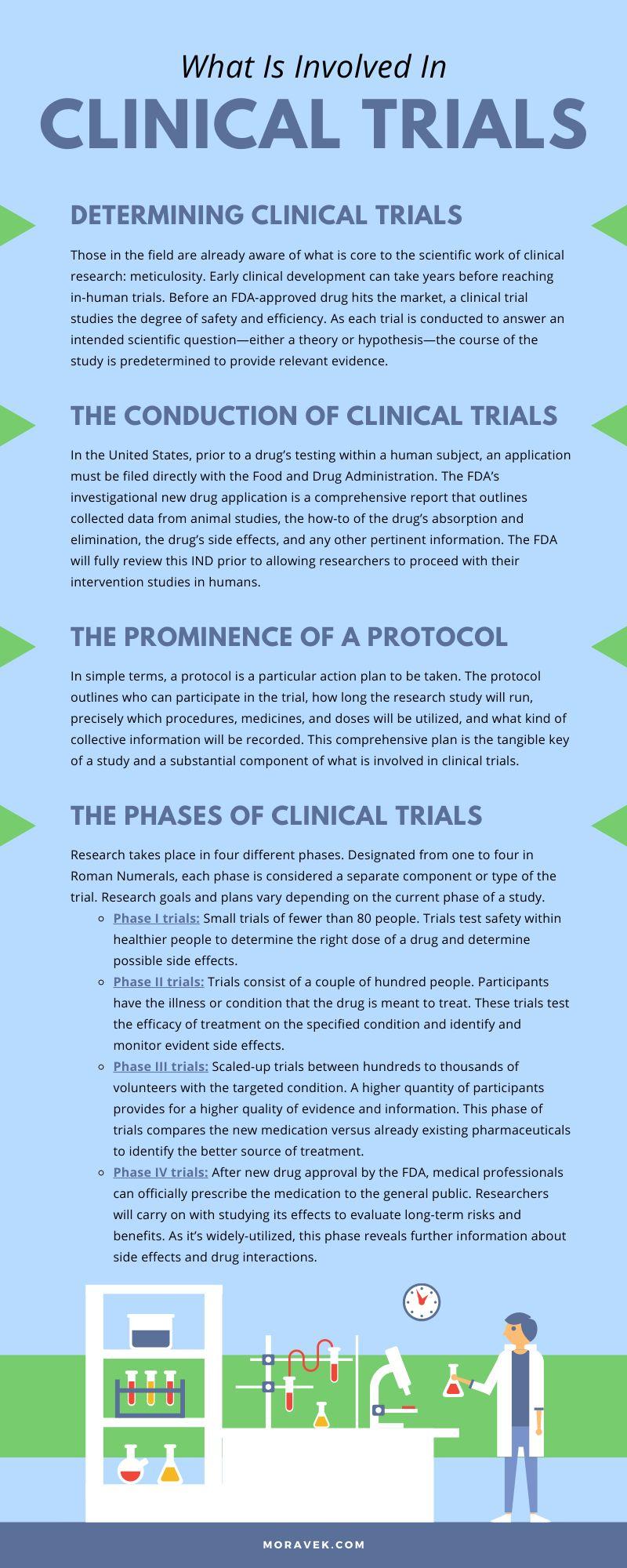
General research is undoubtedly valuable to humankind—under no circumstances is the methodology underwhelming, but rather thorough, extensive, and complex to fill voids in knowledge and discover satisfactory methods that can better communities. Research is integral to the coalition of the medical field that strives to preserve and optimize human life. Because of medical research studies that involve people, professionals in the healthcare industry can provide cutting-edge treatment options and advanced care opportunities.
Carefully constructed and conducted research studies are performed through the means of clinical trials. As final stages of the research process, these critical determinants are sources of investigation for medical advancement. There’s a great number of tactics and approaches involved throughout the entire process of a trial. Here’s an overview of what is involved in clinical trials and studies.
Determining Clinical Trials
Those in the field are already aware of what is core to the scientific work of clinical research: meticulosity. Early clinical development can take years before reaching in-human trials. Before an FDA-approved drug hits the market, a clinical trial studies the degree of safety and efficiency. As each trial is conducted to answer an intended scientific question—either a theory or hypothesis—the course of the study is predetermined to provide relevant evidence.
Since processes are initiated in laboratory settings, preliminary experimentation is done solely through test tubes. Laboratory animal studies come next. These preclinical phases encompass extensive research about the effectivity, toxicity, pharmacokinetics, and safety information of an intended pharmaceutical drug. The precursory goal of attaining substantial evidence is pivotal to move into the beginning clinical stage—the stage which allows for human testing.
A myriad of methods presently utilized in healthcare were once tested on human participants to evaluate the biological or biomedical aftereffects upon the subjects. Today’s currently researched medicine can categorically be tomorrow’s golden standard of care.
The Conduction of Clinical Trials
In the United States, prior to a drug’s testing within a human subject, an application must be filed directly with the Food and Drug Administration. The FDA’s investigational new drug application is a comprehensive report that outlines collected data from animal studies, the how-to of the drug’s absorption and elimination, the drug’s side effects, and any other pertinent information. The FDA will fully review this IND prior to allowing researchers to proceed with their intervention studies in humans.
Research teams that conduct clinical trials are traditionally comprised of medical doctors, nurses, scientists, and healthcare professionals. Additionally, trials can be funded by pharmaceutical companies or non-profit organizations. The key personnel are responsible to ensure adequate control and full compliance with an established protocol.
The Prominence of a Protocol
In simple terms, a protocol is a particular action plan to be taken. The protocol outlines who can participate in the trial, how long the research study will run, precisely which procedures, medicines, and doses will be utilized, and what kind of collective information will be recorded. This comprehensive plan is the tangible key of a study and a substantial component of what is involved in clinical trials.
The protocols of clinical trials must initially be looked over, reviewed, and approved by a grouping of experts known as the Institutional Review Board (IRB). This administrative review board is responsible for examining all research that involves human participants. The IRB is thoroughly concerned with safeguarding the rights, privacy, and welfare of human research volunteers in trials. Their authority is paramount to monitor conditions throughout the study—the IRB can either approve or disapprove select procedures.
Notably, the IRB has a minimum of five members from a variety of backgrounds with the aim of assembling an adequate review board that culminates the legal, scientific, and social implications of human research. Doctors, researchers, and members of the community compromise the IRB. The IRB will also consist of at least one member who is not affiliated with the organization, and at least one member who is not a scientist.
A Data Safety Monitoring Board (DSMB) is another committee that monitors safety within clinical trials. As experts in the clinical research industry, their aim is to provide impartial advice for participant safety, most often in the context of health benefits or risks throughout the entirety of a study. The DSMB can recommend to the FDA that a particular trial is non-effective, harmful, or nonoperating its once viable scientific purpose.
The Phases of Clinical Trials
Research takes place in four different phases. Designated from one to four in Roman Numerals, each phase is considered a separate component or type of the trial. Research goals and plans vary depending on the current phase of a study.
PhaseI trials: Small trials of fewer than 80 people. Trials test safety within healthier people to determine the right dose of a drug and determine possible side effects.
Phase II trials: Trials consist of a couple of hundred people. Participants have the illness or condition that the drug is meant to treat. These trials test the efficacy of treatment on the specified condition and identify and monitor evident side effects.
Phase III trials: Scaled-up trials between hundreds to thousands of volunteers with the targeted condition. A higher quantity of participants provides for a higher quality of evidence and information. This phase of trials compares the new medication versus already existing pharmaceuticals to identify the better source of treatment.
Phase IV trials: After new drug approval by the FDA, medical professionals can officially prescribe the medication to the general public. Researchers will carry on with studying its effects to evaluate long-term risks and benefits. As it’s widely-utilized, this phase reveals further information about side effects and drug interactions.
API Sourcing and Manufacturing
Clinical research testing is a finely toothed process that results in the manufacturing of a new medication. Within the industry today, there are hundreds of pharmaceutical manufacturing companies located around the world. The U.S. is the prevailing pharmaceutical market and is home to one of the leading API manufacturing companies on the market today.
For custom API products you can trust, look to Moravek. As a renowned radiochemistry laboratory, our radiolabeled active pharmaceutical ingredients can support medical research and meet all regulatory requirements. 100% of our materials are suitable to be utilized in the early phases of clinical trials here in America and around the world. Contact us to begin a radiolabeling campaign today.

